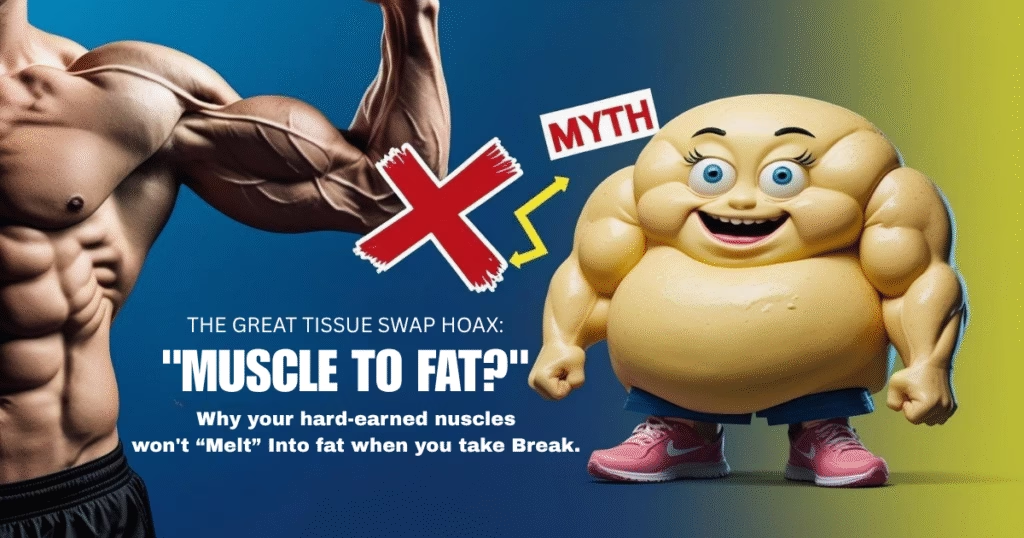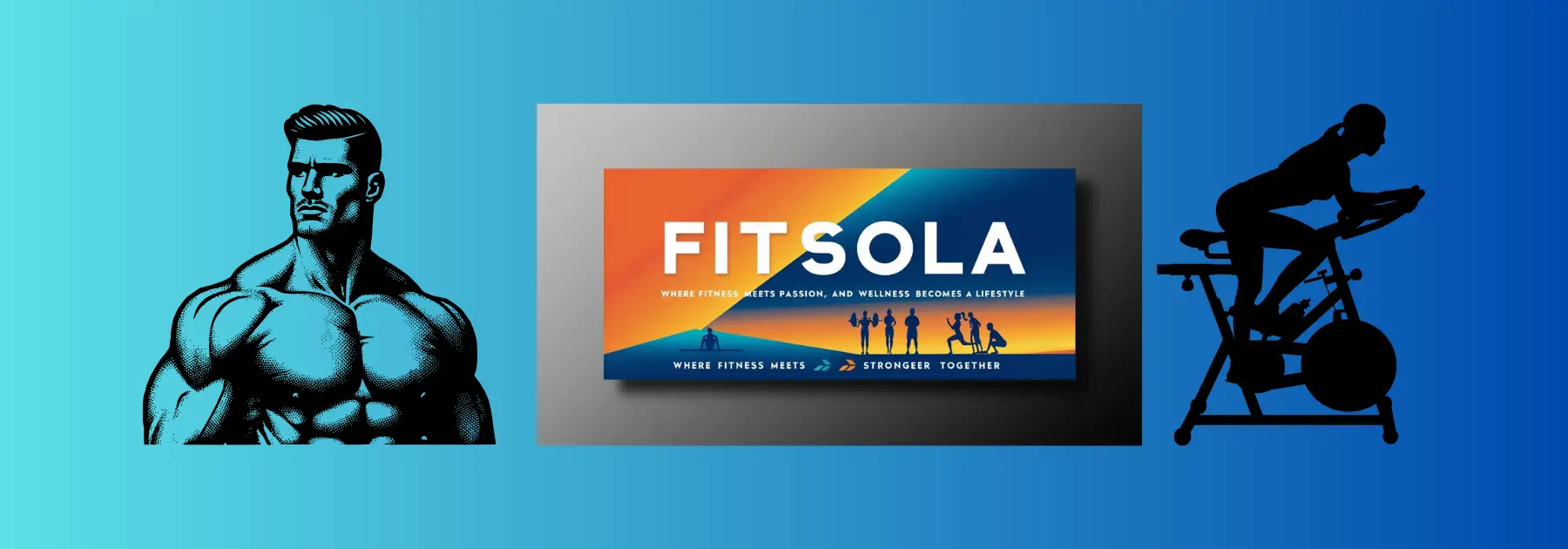You’ve heard the horror story behind the Tissue Swap Hoax: After months of dedication at the gym, life gets busy. Your weights gather dust. Then, you notice it—your once-defined arms look softer, your waist thicker. The alarming conclusion? “My muscle is turning into fat!” It sounds plausible. It feels like a biological betrayal. And it’s complete nonsense.
Let’s cut through this pervasive fitness myth once and for all. Muscle cannot morph into fat, any more than an apple can transform into an orange. They’re fundamentally different tissues with distinct structures, functions, and biological pathways. When you stop training, two separate processes occur:
- Muscle atrophy: Your muscle fibers shrink due to disuse.
- Fat accumulation: Excess calories may be stored as adipose tissue.
The illusion of “conversion” happens because these processes often coincide when activity drops. But claiming muscle turns to fat is like blaming melting ice cubes for your flooded basement—confusing correlation with causation .
Why This Myth Persists (And Why It’s Dangerously Misleading)
The Origins: This myth likely stems from observable body changes in retired athletes or people who stop exercising. A quarterback retires; a year later, he looks softer. A bodybuilder takes a break; his physique appears less defined. The visible shift from “toned” to “softer” gets misinterpreted as tissue transmutation.
The Psychological Hook: This narrative taps into fitness anxiety. It implies that taking a break from the gym guarantees physical decline—a fear-based tactic that keeps people chained to unsustainable routines. Worse, it suggests muscle and fat are interchangeable, undermining the unique value of each.
The Scientific Reality:
- Muscle tissue is metabolically active, built from proteins (myosin, actin), and contracts to generate force.
- Fat tissue (adipose) stores energy as lipids, cushions organs, and regulates hormones.
Biochemically, converting proteins (muscle) into triglycerides (fat) would require dismantling amino acids into carbon skeletons, then rebuilding them into lipids—a process never observed in human physiology . As researchers bluntly state: “Muscle cannot turn into fat, just as paper towels can’t turn into dollar bills” .

Defeat The Myths – Reignite your energy and metabolism with The Proven Supplement and start transforming how you feel, function, and burn fat from the inside
What Actually Happens When You Stop Working Out
When activity decreases, your body undergoes predictable—but entirely separate—changes:
1. Muscle Atrophy: “Use It or Lose It”
Within 72 hours of inactivity, protein synthesis rates drop. After 2–3 weeks:
- Muscle fibers shrink (not disappear) due to reduced myofibrils.
- Strength declines faster than size, as neural efficiency drops.
- Metabolic impact: Every pound of muscle burns ~6 calories/day at rest—only slightly more than fat (~2 calories). The real loss? Your capacity to burn calories during activity .
🔑 Key insight: Muscle loss isn’t “conversion”—it’s disuse-driven shrinkage. Like a deflating balloon, the structure remains but occupies less space .
2. Fat Gain: The Energy Balance Equation
If calorie intake stays constant while activity drops:
- Surplus calories get stored as triglycerides in fat cells.
- Fat cells expand (hypertrophy), particularly around the abdomen.
- Aging accelerates this: After 40, muscle mass declines 3–8% per decade, while fat redistributes centrally—even if weight stays stable .
3. The “Perfect Storm” Scenario
Imagine you stop training but keep eating like an active person:
- Your shrunken muscles burn fewer calories.
- Excess energy floods unused fat cells.
- Result: You look “softer” at the same weight, creating the illusion of muscle “melting” into fat.
Why the Muscle-Fat Ratio Matters More Than Weight
Obsessing over the scale fuels this myth. Two people weighing 180 lbs can look radically different based on body composition:
| Trait | High Muscle/Low Fat | Low Muscle/High Fat |
|---|---|---|
| Visual Appearance | Firm, defined | Soft, less toned |
| Metabolic Health | Better insulin sensitivity | Higher diabetes risk |
| Disease Risk | Lower heart disease risk | 53% higher cardiovascular events per 10cm² muscle fat |
| Functional Impact | Stronger joints, less pain | Higher musculoskeletal pain |
Muscle fat infiltration (IMAT)—fat within muscle tissue—is now linked to coronary dysfunction better than BMI predicts. This isn’t “muscle becoming fat”; it’s pathological fat invading muscle spaces .
How to Protect Your Physique (Even When Life Gets Busy)
You can minimize muscle loss and fat gain during breaks with these strategies:
1. The “Minimum Effective Dose” for Muscle Retention
- Strength train 1–2x/week: Even 1 weekly session maintains 90% of strength for 8 weeks.
- Focus on eccentric moves: Slow lowers (3–5 seconds) during bodyweight squats or push-ups reduce atrophy.
- Prioritize protein: Consume 1.6g/kg/day (e.g., 110g for 150lb person) to suppress muscle breakdown .
2. Calorie Adjustments: The Silent Hero
When activity drops:
- Reduce calories by 15–20% immediately.
- Track waist circumference: If it increases >0.5 inches in 2 weeks, cut another 10%.
- Food quality matters: Higher protein/fiber, lower sodium/carbs reduce fat-to-muscle ratios independent of exercise .
3. Non-Exercise Activity Thermogenesis (NEAT)
- Fidgeting, walking, standing burns 100–800 extra calories/day.
- After stopping workouts:
- Take 5-minute walks every 90 minutes.
- Use a standing desk.
- Cycle errands instead of driving.
4. Embrace “Micro-Workouts”
No time for the gym? Try:
- Isometric holds: 3×60-second planks daily.
- Stair sprints: 3 flights, 5x/day.
- Carry training: Groceries in one walk (farmer’s walk style).
The Liberating Truth: Fitness Isn’t a Prison Sentence
The “muscle to fat” myth thrives on all-or-nothing thinking. But biology doesn’t work in binaries. Taking a break doesn’t reset progress to zero—it simply presses pause.
Reality Check:
- Muscle memory accelerates regain. Nuclei in muscle cells persist for years, making rebuilding faster than building new .
- A 2-week break causes minimal loss; 80% rebounds within 2 weeks of retraining.
“Inactivity can cause muscle cells to shrink and fat cells to expand. But that’s not conversion—it’s two independent processes. Control one, and you control the outcome” .
Always Remember That Nutrition is The Cornerstone in Your Fitness Journey – Truste Supplement is Your Best Friend Along The Way
Final Thoughts: Your Body Isn’t Alchemy
The myth that muscle “turns into” fat is more than scientifically wrong—it’s disempowering. It frames the body as a traitor, rather than a responsive system shaped by inputs.
True fitness freedom comes from understanding:
- Muscle and fat are separate compartments. Train (or don’t train) one without blaming the other.
- The scale is meaningless without context. A 5-lb “gain” could be 4lbs muscle + 1lb fat—a health win .
- Sustainability beats intensity. Do what you can maintain for decades, not months.
So next time someone gasps, “Don’t quit the gym—your muscle will turn to fat!” smile and tell them the truth: “Nope. But I might throw my scale into a volcano.”
What fitness myth annoys you most? Share your pet peeves below!



